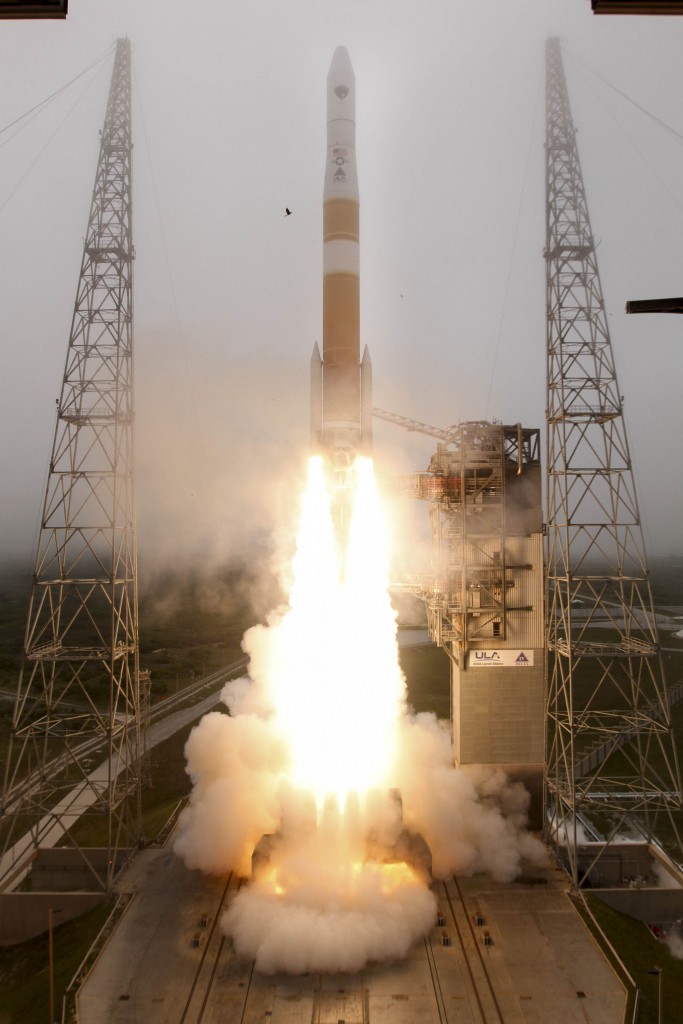
CAPE CANAVERAL — Climbing away from Earth on the power of its liquid hydrogen-fueled main engine and twin solid rockets, a Delta 4 booster successfully launched a new Global Positioning System satellite Wednesday to benefit U.S. military operations and civilian society as a whole.
“This thing called GPS is such a treasure to humanity,” said Lt. Col. Matthew Brandt, 2nd Space Operations Squadron ops director .
Lifting off at 2:36 p.m. EDT, the 721,000-pound Delta rocket rapidly darted through fog hanging over pad 37B at Cape Canaveral Air Force Station in Florida and arced to the northeast to reach Plane B of the navigation network.
It is in that orbital grouping that a once-retired, 22-year-old GPS satellite brought back to life is finally being replaced after Air Force ground controllers extracted all the useful out of the bird.
The Delta 4 finished first stage in four minutes, then transitioned to its second stage and jettisoned the 13-foot diameter, 39-foot-long composite nose cone. The second stage’s initial burn reached a preliminary orbit, concluding less than 16 minutes into flight over the North Atlantic.
Coasting above Europe, the Middle East and Indian Ocean, a second burn by the second stage more than three hours after liftoff finished the powered phase of flight to reach the proper orbit, the 24th successful Delta 4 launch for the Air Force.

Deployment of the $245 million payload into an 11,000 nautical mile circular orbit, tilted 55 degrees to the equator occurred 3 hours and 14 minutes into flight.
“In my humble opinion we must protect and augment GPS to ensure it meets the user’s needs,” said Dr. Brad Parkinson, one of the founding fathers of GPS.
“The signals are great, accuracies down to a millimeter, availability close to 100 percent and a GPS receiver costs about a dollar and a half.”
The new satellite will be checked out and enter service in a month’s time, becoming the ninth Block 2F spacecraft in the constellation. The Boeing-built satellites feature improved accuracy, enhanced anti-jamming and longer design lives.
GPS 2F-9 will replace the GPS 2A-22 satellite originally launched aboard Delta 222 on August 30, 1993.
It previously was decommissioned from active service in 2009, hung around in orbit as a spare, then was set usable again in 2011. The satellite was declared unusable in 2013 and decommissioned a second time. It was tested yet again in 2014.
Now, a fresh spacecraft is going up as a permanent replacement.
There are 30 operational satellites today, including three GPS 2A, 12 GPS 2R, 7 GPS 2R-M and eight GPS 2F spacecraft.
“Right now, we’re running a full GPS constellation,” said Bill Causey, Aerospace Corp. senior project leader for spacecraft and system engineering. “It provides very accurate navigation and timing signals for customers.”
The continuous navigation signals emitted by GPS satellites allow users to find their position in latitude, longitude and altitude and measure time. A GPS user receiver measures the time delay for the signal to reach the receiver, which is the direct measure of the apparent range to the satellite.

“GPS is very simple concept but very, very difficult to implement in its greatest detail,” said Rita Lollock, Aerospace Corp. general manager of the navigation division.
Measurements collected simultaneously from four satellites are processed to solve for the three dimensions of position, velocity and time.
The constellation is comprised of six orbital groupings, or planes, that circle the planet at a tilt of 55 degrees inclination relative to the equator, allowing their paths to cover most of the populated globe.
“The entire world now depends on GPS for navigation and for timing, and it’s a signal you can trust,” Causey said.
Today’s launch was the 371st for a Delta rocket since 1960 and the 29th Delta 4 vehicle. It also marked the 69th GPS satellite launch, the 55th to use a Delta rocket and the sixth Block 2F on Delta. For United Launch Alliance, it was the company’s 95th launch overall since 2006 and the fourth of 13 this year.
ULA intends to phase out the Delta 4-Medium configurations, leaving only the triple-body Delta 4-Heavy rocket in service after 2019. The company will continue flying the less-expensive Atlas 5 rocket and develop its Next Generation Launch System vehicle with an American-made main engine.
“The NGLS will have an American engine, it will be less expensive and it will have greater capability than our current fleet,” said ULA President Tory Bruno.
“We are the world’s premier provider of launch services. We build rockets and fly our rockets from LEO (low-Earth orbit) to Pluto. We launch our country’s most important payloads and we touch your lives every single day. If you ever used a GPS to find where you are going, we helped you get there.”
As few as 15 Delta launches now remain through 2020. See our page with flight history and the remaining backlog of the Delta 4 rocket.
See our earlier GPS 2F-9 coverage.
And see our Delta archive for further information.



